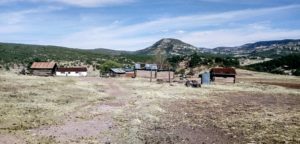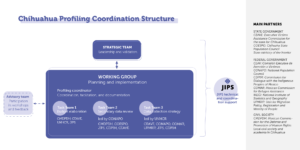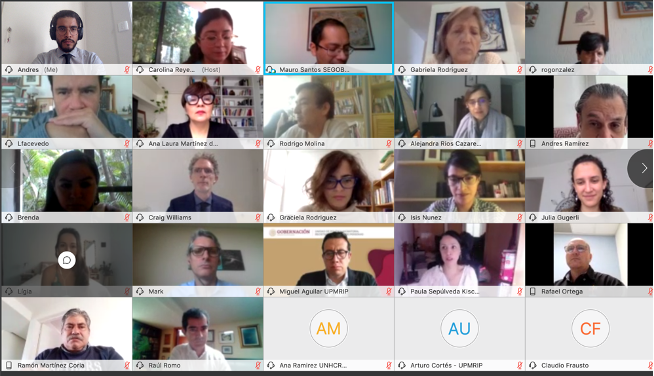Political will to respond to internal displacement in Mexico has passed a threshold since 2019, with the government turning 180 degrees on the recognition of the issue of forced displacement. Concrete steps are being taken and we are thrilled to announce that JIPS is supporting a profiling process in Chihuahua, Mexico. While the COVID-19 pandemic already has and is expected to pose further challenges, especially with regard to data collection, partners and stakeholders remain committed to move the process forward. This article will shine a spotlight on the progress achieved so far and where we are heading to keep the political momentum going whilst adjusting to the new circumstances of working amidst the global pandemic.

Of 511 cases of internal displacement assisted by civil society organisations and CEAVE, 50% involve indigenous communities such as the Rarámuri and Odami, mainly based in the Sierra Tarahumara.
As you might know from our previous article on JIPS’ support in Mexico, the Mexican Government officially recognised internal displacement in the country in April 2019 and since has been stepping up on the issue. The Mexican Congress just passed earlier this month a legislative bill that includes an IDP law, which is now moving to Senate. Furthermore, the presidential report for 2019-2020 features the publication of a government report on the profiles of the internally displaced; the cooperation with UNHCR, JIPS, and IDMC on capacity building; and the government’s collaboration with the Comisión Mexicana de Defensa y Promoción de Derechos Humanos (CMDPDH) to host a JIPS mission to Mexico in November 2019.
This marks a significant about-turn from the previous administration whose Government’s Ministry of the Interior stated in a letter back in 2015: “the existence of any of the elements necessary for the presence of internal forced displacement is not proven, therefore its recognition is not possible”[1]. In contrast, the current government is turning a new page on the country’s history by taking concrete steps to respond to internal displacement. However, despite efforts by the government and civil society, comprehensive and quality data on the phenomenon is still scarce, posing a challenge for the design and planning of the response.
You may recall that JIPS went on a scoping mission in November 2019 to support in the strengthening of capacities on information management on internal displacement and produced seven recommendations. The global pandemic broke out just as partners were discussing the prioritisation of the seven recommendations that resulted from our mission and elaborating a related workplan for 2020. To help move the project ahead amidst the pandemic, JIPS organised a series of workshops on prioritisation and next steps. Based on these discussions, partners decided to prioritise a profiling exercise in Chihuahua.
Since 2017, when the Executive Victims Assistance Commission for the State of Chihuahua (CEAVE) was created, the state government has been assisting IDPs. In 2019, the National Commission on Human Rights (CNDH)[2] made recommendations in favor of 102 IDPs in a case the CMDPDH had been representing. As a result, the CEAVE carried out a baseline assessment based on the information obtained from the 373 IDPs it had assisted and in-depth interviews with 18 displaced households. It also started working on a protocol for the assistance of IDPs and managed to have dedicated resources approved to implement related efforts.
However, it soon became clear that the available qualitative baseline study wasn’t enough for comprehensive planning and decision making to respond to internal displacement at state level. It is against this background that the profiling exercise was launched to produce a shared evidence base that can inform the design of this protocol, the allocation of the budget, and potential future state laws or policies on internal displacement. Furthermore, the exercise will serve as a pilot for similar data collection efforts in other states.
As a first step, partners established a Technical Working Group and agreed on the overall objectives and the coordination structure (see below). Subgroups were established to understand the existing information landscape and the impact of the pandemic on the exercise, to ensure the profiling results fill relevant data gaps.
The secondary data review, led by a subgroup comprised of government and civil society actors, with the technical support of JIPS, identified and analysed existing information sources and data gaps. The group found that most information on internal displacement comes from qualitative studies or media reports. This information illustrates the general dynamics and demographics of displacement, but cannot be extrapolated to the state level. Thus, the profiling exercise will complement existing data to foster an enhanced understanding of the scope, dynamics, causes, and impacts of displacement, as well as the profiles, main protection concerns and vulnerabilities of IDPs specifically. Another subgroup, led by UNHCR and involving federal and state government agencies, is also looking into risk management strategies for data collection in Chihuahua, particularly amidst the COVID-19 pandemic.

Chihuahua profiling coordination structure
While all this sets the profiling exercise up for success in terms of the quality and use of the data and analysis, another main component of our work is to foster collaboration and incentivise political will. The establishment of the coordination structure grouping over 20 organisations from federal and state government, civil society and the international community makes this one of our largest and most complex exercises. While not always easy to manage and particularly challenging to set up without the possibility for in-person meetings, this space allows for conversations between civil society and government that didn’t take place before. Partners have recognised the relevance of this forum and requested for the meetings of the TWG to continue beyond the profiling, to provide a space to discuss topics related to internal displacement in Chihuahua.
“We have to be careful not to carry out data collection without aiming to create change. IDPs have seen that there hasn’t been any work towards solutions, just humanitarian assistance. While this is a profiling exercise, from the first moment of interaction we are committing to work for and to assist IDPs […]. We should aim to leverage this space and occasionally have discussions that are not analytical but pragmatic. This gathering of stakeholders is very important. There hasn’t been a similar gathering in Chihuahua before.” – Ramón Martinez Coria, CDPIM
During a high-level meeting mid-September, the Technical Working Group presented the progress made with the profiling and partners reiterated their endorsement and support. The group is currently in the process of recruiting a profiling coordinator, drafting the budget, and finding agreement on the geographic scope and funding mechanisms for the exercise. Then, an official launch of the exercise with Chihuahua state government officials is planned before working on developing the methodology and tools for data collection.

High-level online meeting with partners in Mexico, September 2020
This progress has led to renewed interest from Chiapas State, where we hosted a workshop during the scoping mission in November. The State Human Rights Commission (CEDH) has been leading an effort to initiate another profiling exercise there.
While the measures in place to prevent the spread of COVID-19 won’t make this easy, the exercise is a priority for partners and should ideally move ahead before the end of the year.
–
[1] In the official letter No. UDDH/911/DGAEI/920/2015, dated October 29, 2015, and cited by the National Human Rights Commission in its Special Report on Forced Internal Displacement in Mexico, after an analysis based on the causes established by the Guiding Principles on Internal Displacement, the Human Rights Defense Unit of the Ministry of the Interior concludes that “the existence of any of the elements necessary for the presence of internal forced displacement is not proven, therefore its recognition is not possible”. See: CNDH (eds.), Informe especial sobre Desplazamiento Forzado Interno en México, 2016, Para. 239.
[2] CNDH, Recomendación No. 94/19. Sobre el caso de desplazamiento forzado interno de 80 personas integrantes de un grupo familiar originario del estado de Chihuahua, 2019, available at: https://www.cndh.org.mx/sites/default/files/documentos/2019-10/REC_2019_094.pdf